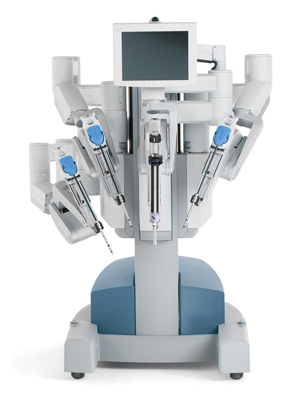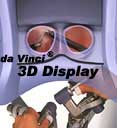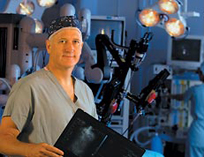
da Vinci Robotic Surgery
The Surgical System
The da Vinci Robot* gives the surgeon new tools for minimally invasive laparoscopic surgery. The robotic system was originally developed by the Department of Defense for use as a robotic surgeon for the battlefield and is approved by the FDA. The system replicates the surgeon's hand movement's real-time in laparoscopic instruments. It cannot be programmed, nor does it make any independent decisions, but rather it does only what the surgeon inputs in real-time.
The da Vinci Robotic 3D Camera
Standard laparoscopic viewing utilizes one single camera and limits surgeon's vision to a 2-D view similar to watching your da Vinci 3D display image television. The da Vinci robotic camera consists of TWO high resolution fiber  optic cameras. Like your eyes they produce a true 3 dimensional color picture available to the surgeon seated at the da Vinci console by viewing the twin high resolution, high frame-rate eyepieces. Endoscope picture Magnification of up to 10-12x can be achieved with these cameras. These components constitute the Insite Vision System, by Intuitive Surgical, one of the most advanced vision systems available. A central robotic arm positions the camera and lighting exactly where the surgeon wishes it, because it is operated by the surgeon by foot pedals as he/she is comfortably seated at the console. Also note the camera can be placed within 2 inches of the prostate during robotic surgery. Two different cameras are also available: straight, and 30 degree oblique. The oblique camera can allow the surgeon to peek around the corners and to partially see underneath the prostate.
optic cameras. Like your eyes they produce a true 3 dimensional color picture available to the surgeon seated at the da Vinci console by viewing the twin high resolution, high frame-rate eyepieces. Endoscope picture Magnification of up to 10-12x can be achieved with these cameras. These components constitute the Insite Vision System, by Intuitive Surgical, one of the most advanced vision systems available. A central robotic arm positions the camera and lighting exactly where the surgeon wishes it, because it is operated by the surgeon by foot pedals as he/she is comfortably seated at the console. Also note the camera can be placed within 2 inches of the prostate during robotic surgery. Two different cameras are also available: straight, and 30 degree oblique. The oblique camera can allow the surgeon to peek around the corners and to partially see underneath the prostate.
The da Vinci Robotic Surgical Instruments

Although visually similar to standard Endowrist image laparoscopic instruments, the robotic instruments have the additional advantage of being articulated. This allows the instruments not only the instrument image to open and close but to fully turn and twist, allowing more natural mimicry of the human hand and wrist. Unlike your hand these instruments are much smaller. Many of the jaws of the tools are similar or shorter in length than your fingernail. This allows very small and precise incisions to carefully dissect out the prostate.
Manipulations of da Vinci Robotic Surgical Instruments

Standard laparoscopic instruments are manipulated counter-intuitively or 'backwards'. The surgeon operates one end of the instrument which acts like a lever-push one end down and the other end goes up. Push right to make the instrument go left. This is similar to a teeter-totter, where the center is the port or entrance to the body cavity. Thus for standard laparoscopic procedure, the surgeon has learned to operate essentially backwards. Although difficult, a highly qualified surgeon can master image this process. The Da Vinci robot does NOT have these limitations. The robot-slave technology translates a surgeons hand movements exactly as he/she does them. Turn your wrist right and the articulated robotic wrist turns right; go up, the robot wrist move up, etc. in three dimensions. The robot also allows the surgeon to 'scale' their hand movements. A large hand movement at the console can be translated into a micro precise dissection or exposure. The robot can also filter out hand tremors, enhancing precision. Another of the many benefits of this system is that it significantly reduces surgeon fatigue associated with traditional laparoscopic prostatectomy by allowing the surgeon to remain in a natural, comfortable position while operating.
Minimizing Blood Loss with the da Vinci Robotic System
Similar to standard laparoscopic procedures, patients are insufflated in the lower abdomen. This gas pressure acts like an invisible hand to suppress blood loss and it also gently sweeps bowel away from the surgical target site. The gas is exhaled away after robotic surgery. The enhanced visibility and magnification of the robotic cameras aid the surgeons in finding small 'bleeders', which translates into lower blood loss. Now surgeons can keep blood loss to a minimum, which means an increased clarity of vision to more carefully identify essential anatomy of the prostate: the edges of prostate (margins), the urethra (continence), and nerves and blood vessels which may aid potency.
Common Questions
How safe is da Vinci Robotic Surgery for radical prostatectomy?
The system is FDA approved for robotic surgery for radical prostatectomies and is being used routinely in a great number of hospitals across the country. Each da Vinci system is rigorously maintained, tested, and upgraded as necessary by Intuitive Surgical. In our experience at UC Irvine Hospital, Orange County, with both of our two da Vinci Systems, we have not seen nor heard anything that would give us cause for concern.
What happens if there is a malfunction during the da Vinci Robotic Surgery?
In the unlikely event of malfunction during the robotic surgery, or if the surgeon feels that it is not safe to continue with the robot, the da vinci system will be withdrawn and the surgery can proceed either via traditional laparoscopic means or via traditional open radical prostatectomy. The instruments and supplies necessary are kept on hand such that conversion, if necessary, can occur seamlessly. Dr. Ahlering was previously an expert in open radical prostatectomy such that good surgical results can still be obtained in this unlikely event.

